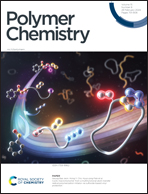Effects of hard nanoconfinement on polystyrene synthesized inside a complex mesoporous material KIT-6
Abstract
Nanoconfinement plays an important role in shaping the properties of polystyrene polymers, particularly their Tg. Although some studies have examined the effects of nanoconfinement, the results have been conflicting, leading to doubts regarding its overall impact. In many cases, preformed polystyrene was inserted into the nanoconfinement. In this study, we synthesized polystyrene directly under nanoconfinement using KIT-6, a large-pore mesoporous material with highly ordered 3D bicontinuous body-centered (Ia3d) cubic symmetry. We employed mesoporous materials with three pore diameters. Our findings show that polystyrene synthesized under confinement leads to polymers with a 30% lower dispersity and glass transition temperatures up to 20 degrees lower than those of traditional polymers. All the properties reverted to traditional values when the polymer was extracted from the nanoconfinement, providing evidence of the confinement effect. The DSC curves, thermogravimetric curves, and their correlation with the molecular mass suggest that the polymers synthesized under nanoconfinement have a more stacked structure inside the porous material. Our work demonstrates that hard nanoconfinement can lead to the synthesis of polymers with unique properties, deepening our understanding of the effect of nanoconfinement under hard confinement conditions.



 Please wait while we load your content...
Please wait while we load your content...